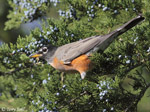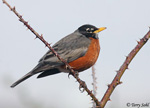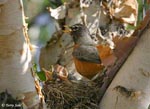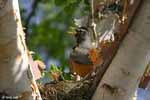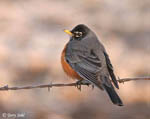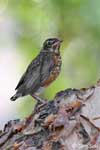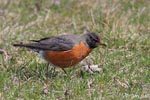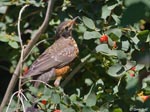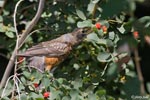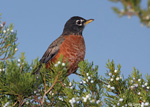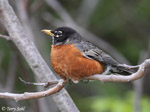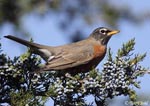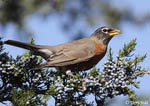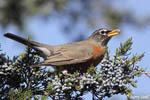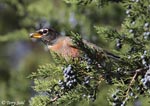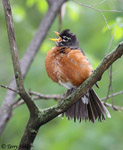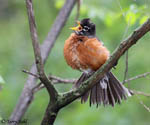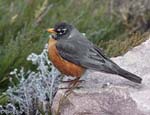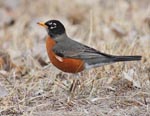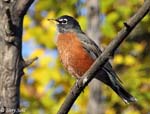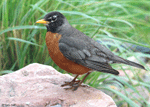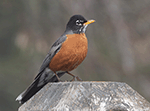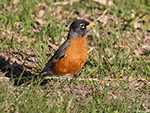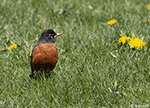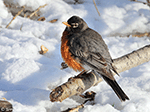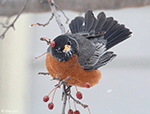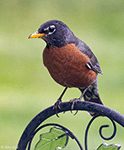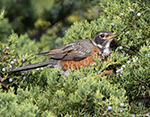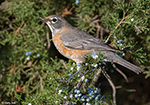| Length: 10 inches | Wingspan: 15 inches | Seasonality: Summer / Migrant |
| ID Keys: Distinctive, with brick red chest, dark upperparts, white around eyes, yellow bill. | ||
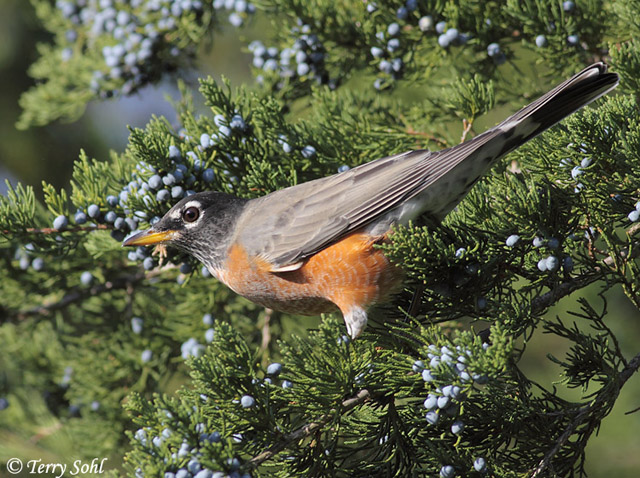 The
American Robin is a very common and familiar bird across the state. Well
adapted to living with humans, they will readily nest and forage near dwellings. They are often seen in suburban
settings, running across lawns as they forage. Their song is also one of
the best known bird songs in much of North America, a warbling song that is
often given very early in the morning.
The
American Robin is a very common and familiar bird across the state. Well
adapted to living with humans, they will readily nest and forage near dwellings. They are often seen in suburban
settings, running across lawns as they forage. Their song is also one of
the best known bird songs in much of North America, a warbling song that is
often given very early in the morning.
Habitat:
Residential areas, parks, farmland, forest edges and clearings, and other open or semi-open habitats. American Robins often stay near berry sources when wintering.
Diet:
Mostly fruit and berries, insects, and earthworms.
Behavior:
Primarily forages on the ground, where earthworms are a favorite item. Will also forage in trees and shrubs for berries. During the winter months, they tend to become more concentrated and localized, especially in the northern part of their range.
Nesting:
Late April through July. The nest of an American Robin is a cup of grasses, sticks, and weeds, with mud used to cement the nest together. The female usually lays 3 to 5 eggs, and the female alone incubates them. When the eggs hatch, both parents help to feed the young. The young fledge after 2 weeks or more.
Interactive eBird Map:
Click to access an interactive eBird map of American Robin sightings
Song:
The song of an American Robin is a series of sweet whistled phrases. Calls are short sharp notes, sometimes given in rapid succession.
- Click here to hear the song of an American Robin, recorded in Loup County, Nebraska1
- Click here to hear the scolding call of an American Robin, recorded in Colorado County, Texas2
Migration:
Migratory, but gathers in large flocks and can be found in scattered locations in the winter. Wide variation in numbers from winter to winter and from location to location. In South Dakota, varying numbers overwinter in the state, with more found in the southern part of South Dakota. From a personal observation, it does seem more and more are attempting to overwinter in southeastern South Dakota with each passing year.
Similar Species:
Not many species could potentially be confused with an American Robin in South Dakota (and much of their range). However, the following species offer some identification challenges if a bird isn't seen well:
- Varied Thrush - Another Thrush species with a similar body structure, size, and coloring, the Varied Thrush is but a rare winter visitor to South Dakota. While both have dark upperparts and orangish underparts, the pattern on an American Robin is much cleaner and simpler, with less variation in coloring on both the solid orange belly and on the solid dark body. In contrast, Varied Thrush have orangish wing bars, an orange stripe behind the eye, and a black "necklace" that bisects the orange on its underparts.
- Eastern Towhee - Another species with dark upperparts and extensive orange underneath. However, Eastern Towhees have a very different dark bill (compared to the yellow bill on an American Robin), white wing bars (clean wings on an American Robin), and a orange that only covers the flanks of the bird, with a white underbelly (all orange breast and belly on a Robin). Eastern Towhees are also noticeably smaller birds.
- Spotted Towhee - Spotted Towhees are very similar in appearance to an Eastern Towhee, with a dark head and back, orange flanks and a white belly. The smaller size and white belly differentiate Spotted Towhee from American Robin.
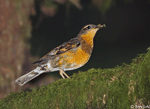 |
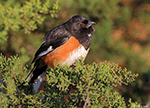 |
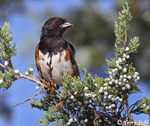 |
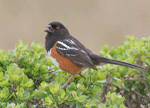 |
| Varied Thrush | Eastern Towhee | Eastern Towhee | Spotted Towhee |
Feeders:
Breadcrumbs. Note that I personally have had Robins feed on shelled sunflower kernels that had fallen on the ground below a hanging feeder, and I've also had them occasionally feed on fallen (shelled) peanuts. They'll feed on suet as well if they can access it, particularly in colder weather. I have an oriole feeder with cups for jelly and spikes for orange halves, and American Robins will sometimes feed on both of those as well.
Birdhouses:
Will use nesting shelves. Also will nest on semi-protected areas of buildings.
Conservation Status:
Numbers are stable or possibly increasing, they are found across a very wide geographic area, and they are very common in many parts of their range. The IUCN lists the American Robin as a species of "Least Concern".
Further Information:
Photo Information:
June 21st, 2001 -- Brandon, Minnehaha County -- Terry L. Sohl
Additional Photos:
Click on the image chips or text links below for additional, higher-resolution American Robin photos.
Audio File Credits:
- 1Bobby Wilcox, XC468243. Accessible at www.xeno-canto.org/468243
- 2Paul Marvin, XC452509. Accessible at www.xeno-canto.org/452609
| Click on the map below for a higher-resolution view |
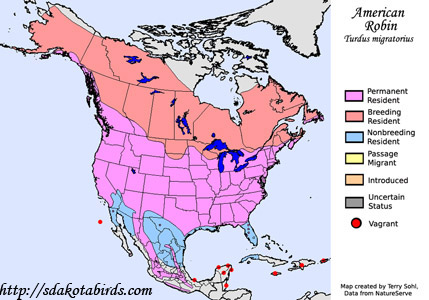 |
| South Dakota Status: Common summer breeding resident. Numbers can vary greatly from year-to-year and between locations in the winter, from rare to locally common. |
American Robin Photos
